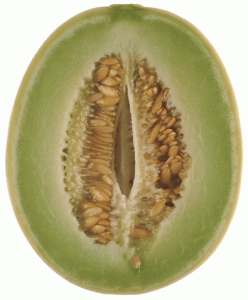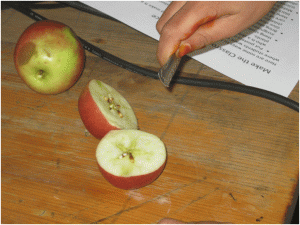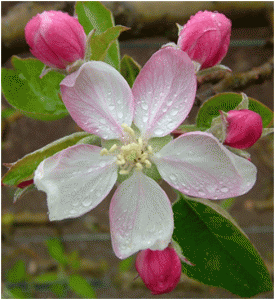Check an Apple for Pollination
by Camilla Barry
Subject: Botany
Review pollination with the students. Pollination is the process whereby pollen fertilizes the female part of a flower. Seeds are the result of successful pollination.

If you cut a melon, you will see many seeds (fig 1). Likewise, a sunflower may have several thousand seeds. Does that mean every seed will grow? No. Many melon and sunflower seeds are not complete. There is an outer seed coat, but no embryo inside.
Definition:
Embryo: an organism that is in its earliest stages of development.
Fruits having no seeds or incomplete seeds are proof that pollination wasn’t successful. Fruit can form even if there was no pollination, but the fruit is often smaller and inferior. Apples are an easy fruit to examine for pollination because:
- a) They are readily available
- b) They are inexpensive
- c) The seeds are easy to find
- d) Apples do not contain many seeds, so they are easier to count.

1) Slice an apple crosswise (fig 2). Notice the star-shaped pattern inside. These are the seed “pockets”. How many seed pockets are there? (Five)
Apples have the capacity to hold 2 seeds in each seed pocket. If an apple blossom is completely pollinated, there will be 10 seeds (2 seeds in each of 5 pockets).
2) Use your fingers or a pencil to gently pry seeds from the pockets and count them (fig 3). Are the seeds complete or just a shell? You may have to guess by looking to see how round they are, if you cannot open the seeds. If a seed was sliced in half when the apple was cut, count it as a single seed.

3) More advanced students can calculate the ratio of actual seeds produced to the total seed capacity:
Seeds in my apple
Compare apples from more than one source:
This lesson is much more interesting if apples are purchased from different vendors, or if apples are brought from home gardens. If you purchase the apples, try to discover where they were grown. Then the number of seeds from one type of apple may be compared to the seeds of another type of apple.
Many farmers believe there is a direct relationship between the number of seeds in an apple and the quality of the apple. The apple may be bigger, rounder, or juicier if there are more seeds. Others say they have not noticed such a relationship. Ask your students what they think, after observing their apples and counting the seeds.
Why do some apples have more seeds?
a) Apple trees are pollinated by bees. If there are no bees near the orchard, there will be no pollination, and no seeds.
b) Apple trees must be pollinated with the pollen from another apple tree. Bees must bring the pollen from one tree to another for seeds to form. The trees must be close enough that bees will visit both trees. However, bees can visit trees as far as 1.5 kilometers apart, so the trees do not have to be in the same garden.
Notice 5-part symmetry in apples:
Remember the 5-pointed star shape in the middle of the apple. Can you find another instance of 5-parts on the apple fruit? (the bottom of the apple has a 5-part scar). Look at the picture of the apple blossom (fig 4). What do you notice? (there are 5 petals).

Questions:
1. Can a fruit develop without seeds? (yes)
2. Are all the seeds in a fruit capable of growing? (not necessarily) Why not? (the flower corresponding to that seed may not have been pollinated)
3. Serena sees many bees on the flowers of the single apple tree in her front yard. She is thinks she will be able to gather many seeds from her apples. Is she right? (maybe) What else does she need to be certain of many seeds? (another apple tree nearby).
4. Mohammed Gul is an apple farmer. He has a large orchard of apple trees. He wants to make sure no bugs bother his plants. He sprays pesticide everywhere. The pesticide will kill all bugs. Will he have apples? (Yes. Pesticide does not keep fruit from forming).
5. Will Mohammed Gul’s apples be large and tasty? Why or why not? (They will not have many, or possibly no, seeds because there will be no bees to pollinate the flowers. Some farmers believe there is a correlation between pollination and high-quality fruit.
Alignment to Standards:
Kindergarten Life Sciences: Students know how to identify major structures of common plants and animals (e.g., stems, leaves, roots, arms, wings, legs).
First Grade Life Sciences: Students know different plants and animals inhabit different kinds of environments and have external features that help them thrive in different kinds of places.
Second Grade Life Sciences: Students know flowers and fruits are associated with reproduction in plants.
Third Grade Life Sciences: Students know plants and animals have structures that serve different functions in growth, survival, and reproduction.
Fourth Grade Life Sciences: Students know many plants depend on animals for pollination and seed dispersal, and animals depend on plants for food and shelter.
Camilla Barry teaches K-5 science at Park School in the Mill Valley School District and is founder of Classrooms Across Cultures.





